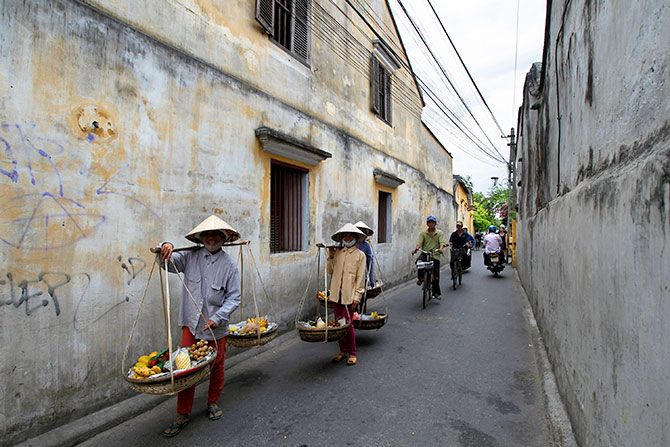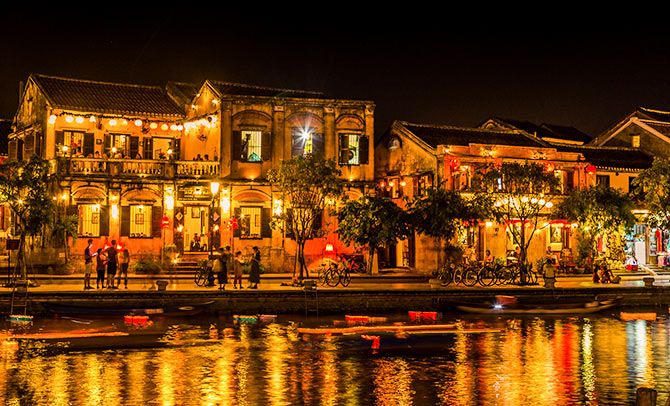 | « Back to article | Print this article |
Geetanjali Krishna landed in the ancient Vietnamese city of Hoi An in the midst of a typhoon warning!

Rain splattered the windows of the plane as we landed at Da Nang airport. The sky was leaden, the ground, sodden. Although we had known that we were planning a vacation in Vietnam during its wettest months of November and December, we'd foolishly hoped to get lucky with the weather.
'There go our plans to chill out on some of the best beaches in Vietnam.' said my husband, little realising worse was in store.
For when we exited the airport, we were told that the storm we had just flown through had been upgraded to a typhoon named Damrey the worst to hit Vietnam since 2001.
We rode to the hotel in silence, looking longingly at the fast rising River Thu Bon in the old town of Hoi An, which we had hoped to explore by boat.
The old town is a UNESCO World Heritage Site, and with its yellow-walled shops, bright blue shutters and vibrant lanterns strung overhead, it looks much like it did several centuries ago.
As we drove past Hoi An's fabled tailors and leather shoemakers, its banh mi (baguettes filled with curried vegetables and meat) stands, lush gardens and coffee shops, one thing became clear. Even if it meant getting soaked to the bone, no typhoon was going to stop us from exploring this exceptionally well-preserved piece of Vietnamese heritage.
So, we changed into flip flops and quick drying clothes and set off to do exactly that.

Our first stop was Brothers Café, a riverside restaurant set in an old building with a traditional courtyard garden.
The trees along the river were festooned with lanterns. Apparently, every full-moon night, Hoi An eschews electric power and is completely lit up by these lanterns.
Over bowls of steaming pho, the flavourful Vietnamese version of ramen, we plotted our next move. Grand architecture, lovely riverside walks and ambles through the old town weren't Hoi An's only attractions, we found. The town had plenty to offer indoors as well.
Once a major port, Hoi An has retained over 800 historic houses, temples and pagodas, covered street food markets and more, which offer glimpses of Vietnamese life quite different from the more urban Ho Chi Minh City and Hanoi.
Walking through Hoi An's beguiling maze of narrow lanes, traditional houses, temples and shops, we lost track of time.
When the rain and winds picked up, we ducked into a traditional temple with a courtyard bedecked with profusely flowering Ixora, tropical Mussaenda and old bonsai trees in embellished urns.
Meanwhile, next door, an obliging shoemaker customised a sandal to the shape of my foot.
When the rain abated, we decided to quickly head to Hoi An's famous covered Japanese Bridge, only to realise that umbrellas in a typhoon are a terrible idea, unless one is into freestyle parasailing. The river was well above the danger mark, so we left the windy riverfront for the cozy interior of Central Market, a big hall crammed with many little cafés selling everything, from fresh seafood to some of the best fruit I've eaten in my life.
The sliced pineapple and durian, the strangely indescribable local delicacy, were to die for, although we were too full to try the local pancakes stuffed with salad and seafood.
Later, we had some much-needed hot coffee at the Hoi An Roastery before calling it a day.

The next morning, as we lingered over an excellent breakfast of pho, croissants and coffee, our plans to explore the old town went awry as the river water began to seep into the hotel. Half an hour later, looking at boats plying on Hoi An's streets, we decided to leave the area while we still could.
Later, I discovered that Typhoon Damrey killed over 106 people in Central Vietnam, and many tourists who, unlike us, had decided to try and weather the storm, had to be evacuated.
But rather than the typhoon that threatened to get me airborne with my umbrella over the choppy waters of River Thu Bon, like a petrified Mary Poppins, what I remember of my time in Hoi An is its old-world charm, and the peaceful countenances of the Vietnamese, who even in high winds and pelting rain, tried to carry on with their businesses for as long as possible.
Hoi An is a 45-minute drive away from Da Nang airport, which in turn connects to both Hanoi and Ho Chi Minh City. Time your travel dates with the full moon to experience the village at its best.